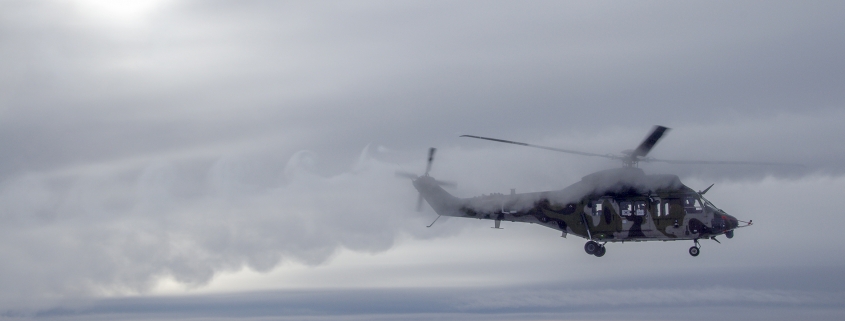Fixed-wing aircraft and helicopters have to be able to operate safely under all certificated conditions. Helicopters operate in situations where in-flight icing can occur, in which case it is necessary to prevent damage to, or performance degradation of components like the engine and rotor blades. The KUH-1 Surion transport helicopter manufactured by KAI recently obtained its icing certification in Korea, enabling equipment and troops to be transported safely in this Korean military helicopter even in icing conditions. NLR assisted in the test campaign that was recently concluded at Michigan’s Sawyer Airforce Base in the United States. NLR researcher Stefan van ’t Hoff explains: “An ice protection system (IPS) is indispensable for helicopters that often encounter situations where icing conditions may occur and where operational availability is very important. Search and Rescue (SAR) operations above sea are a prime example. Above large bodies of water and along the coast, there is often a moist atmosphere that leads to cloud formation. As soon as the temperature in the clouds drops below freezing, it is possible for water droplets in the cloud to become supercooled and, after contact, to form an ice layer on vital parts of the helicopter, like the rotor blades and the engine intake. In general, the engine intake represents a particular risk, because of the possibility of large pieces of ice being sucked into the engine, causing damage, or in the worst case, engine failure.” On the Surion helicopter, an ice detector alerts the pilot when icing conditions are detected. The pilot then manually activates the IPS. The de-icing system of the main rotor periodically allows a layer of ice to accumulate and then heats the blades, causing the ice to shed under centrifugal loads. This is accompanied by periodic variations in the required power and vibration level. In contrast, the engine intake is permanently heated, enabling icing accretion to be prevented completely. The same anti-icing principle is used for the helicopter windows and, in the case of the Surion, also for the wire cutter, located on top of the helicopter cabin near the engine intake.
During the recent flight test campaign, icing conditions were initially generated artificially. Van ‘t Hoff explains: “This was done by getting a U.S. Army CH-47 Chinook helicopter to fly just ahead of the test aircraft at a certain desired test temperature below freezing, and to atomise water through a spray bar system to generate a supercooled cloud, which the test aircraft would then fly through. We later repeated the testing under natural icing conditions above the relatively thinly populated Great Lakes region of the US. For every test, I flew on board a ‘chase’ plane that remained in the vicinity of the test aircraft. This allowed me to determine whether the test conditions were acceptable, whether the test procedures were followed correctly and also to make sure that the ice accretions did not pose a flight safety hazard”. NLR oversaw the initial flight test campaign in 2015/2016 and supported KAI and the military aviation authority in interpreting test results and certification requirements. Based on the outcome of the flight trials, NLR advised on design modifications and was responsible for the redesign of one of the systems. Following a series of icing wind tunnel test campaigns directed by NLR and in close cooperation with KAI, the final flight test campaign performed in the 2017/2018 winter period with a modified system ultimately led to the coveted icing certification.
This contract reinforced the long-standing relationship between KAI and NLR. This relationship has produced various kinds of projects, including, e.g., a test campaign to determine the operational limits for KUH-1M helicopter-ship operations. NLR also aims to use the icing certification and test capabilities it has acquired over the years to support other helicopter manufacturers and the Netherlands Ministry of Defence.



 NLR
NLR Airbus
Airbus